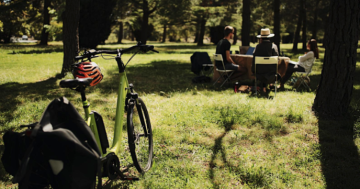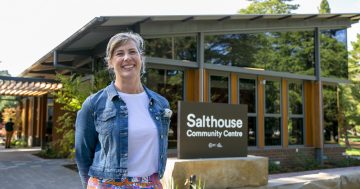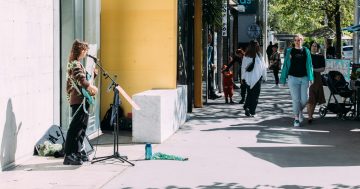
Braddon Collective member Nicholas Seefried on a section of Haig Park’s gravel paths. Photos: Ian Bushnell.
New gravel paths in Haig Park are a safety hazard and people are avoiding them, according to a local residents group.
The Braddon Collective, affiliated with the North Canberra Community Council, has called them dysfunctional, exclusionary and a liability for government.
Member Nicholas Seefried said residents were delighted when the City Renewal Authority announced late last year that work had started on new paths for the iconic inner city park.
Early this year, part of the park was reopened where some concrete paths had been completed, but it had taken a further six or seven months for people to have full access, Mr Seefried said.
“I don’t know what happened between contractor and procurement because we were involved being abreast of what was going on there from the get-go,” Mr Seefried said.
“They said there was going to be some sort of sealant on top of the gravel. That never worked out. And then, obviously, some sort of delay happened. They had fences up for months, six or seven months, in a park with no work going on, and then they finally repaired some little bits of the concrete paths and then left the other areas.”
He said the paths’ layer of loose gravel was difficult for bicycles and prams to negotiate and an accident was inevitable.
Even walkers moved on to the grass rather than walk over the more difficult sections.
The paths were also inconsistent with some sections compacted and sealed for a firm surface, while others were loose underfoot with gravel spilling over the sides onto the grass.
The Braddon Collective had raised their concerns about paths with the City Renewal Authority (CRA) but were told that the job was now complete.
“The main concern is the accident aspect of it and it’s only going to get worse,” Mr Seefried said.
“It’s a path and it’s supposed to transport people. It’s not supposed to be a hazard. If this was your backyard leading up to your apartment and you got this, you wouldn’t pay for the service.”

Not suitable: people with prams have been told to stick to the concrete path.
The CRA had told the Collective the gravel paths were not suited to wheelchairs, prams or bikes and those people should use the concrete paths.
But Mr Seefried said all paths in the park should be accessible for all ages and abilities so no one was excluded.
“It’s worse than before actually because people avoid it,” Mr Seefried said.
He said there used to be a goat track that people would use because they knew it was hard most of the time, “but now you got this thing that people just avoid”.
“It’s decreased the utility of the park in certain areas.”
Mr Seefried said it was a shame the paths should detract from the CRA’s welcome commitment to upgrade the park.
“We’re still very happy that we have the concrete paths and the new community centre underway, but we’re just disappointed in the final product of these side paths,” he said.
He called for the government to conduct a safety audit.
Braddon United Retailers & Traders spokesperson said Kel Watt said the poor construction and condition of the paths were regularly raised with local traders by parents with strollers, cyclists, e-scooter users and pedestrians.
“A couple of nasty falls and bloodies knees have been treated by local shopkeeers,” he said.
“The failure to build a basic path properly, combined with the recent announcement the ACT Government is scrapping promised $9.6m upgrades to Lonsdale and Mort Streets has locals angry about the use of levy funds and their commitment to helping Braddon businesses rebuild.”
A CRA spokesperson said the soft gravel paths were suitable for pedestrians and easier to pass during wet weather but wheeled traffic should use the new concrete paths.
The spokesperson said 820 metres of new pathways had been constructed and new lighting and power bollards installed.
The two types of paths complemented the park’s existing character – a new fully accessible 220-metre concrete path along the east-west axis through the centre of the park, and about 600 metres of interconnecting permeable paths made from crushed rock.
“The paths are wider and level, providing safer direct pedestrian access into Braddon which has eliminated the deep mud and water-filled tracks from the previous ‘desire line’ paths, while still allowing water to reach the roots of the park’s many heritage trees,” the spokesperson said.
“The project supports the creation of high quality, people-friendly public spaces as a result of community feedback embedded in the Haig Park Place Plan, and has enabled the Haig Park Village Market and future events flexibility to extend their footprint through the park.”





















